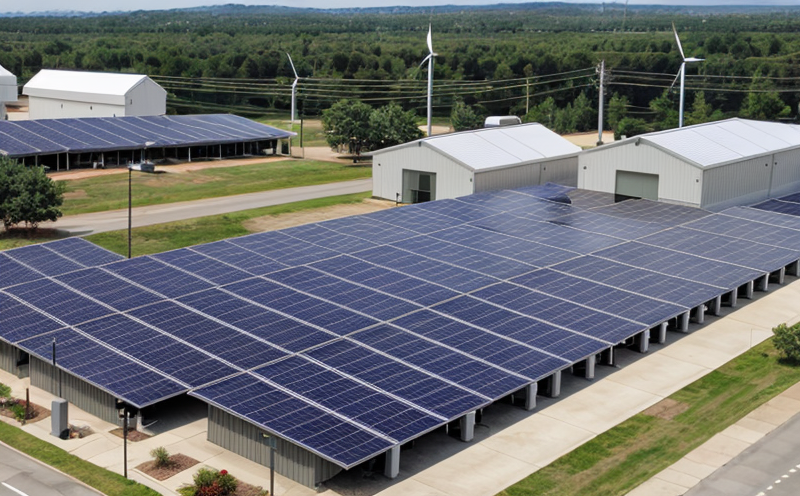EN ISO 14064 GHG Emission Testing of Distributed Energy Systems
The EN ISO 14064 series provides a framework for quantifying, reporting and verifying greenhouse gas (GHG) emissions. The standard is widely recognized in the energy sector for its role in ensuring compliance with international regulations on climate change mitigation. This service focuses specifically on testing distributed energy systems to determine their GHG emissions according to EN ISO 14064-2.
Distributed Energy Systems (DES), comprising microgrids, renewable resources like solar and wind farms, and hybrid power plants, play a crucial role in the global transition towards sustainable energy solutions. Understanding the carbon footprint of these systems is essential for their successful integration into existing grid infrastructure and for meeting regulatory requirements.
EN ISO 14064-2 offers a structured approach to quantify emissions from anthropogenic activities related to the production, distribution, storage, conversion, or consumption of energy. This service ensures that distributed energy systems are evaluated comprehensively using internationally recognized methodologies. The process involves detailed measurement and monitoring protocols, data analysis, and verification procedures.
Before testing can begin, it is important to prepare the system properly for evaluation. This includes ensuring all components are operational and stable over a defined period before measurements commence. Once prepared, the testing procedure follows several key steps:
- Data Collection: Gather data on energy inputs, outputs, and any changes in storage capacity.
- Inventory Calculation: Use the collected data to calculate emissions based on predefined emission factors for each type of fuel or energy resource used.
- Verification: Validate the calculated emissions against external audits and internal reviews to ensure accuracy.
- Emission Reporting: Compile a detailed report outlining all aspects of the testing process, including raw data, calculations, and verification results.
The use of EN ISO 14064-2 ensures that distributed energy systems are evaluated in line with international best practices. Compliance with this standard is not only beneficial for regulatory adherence but also enhances a company’s reputation as an environmentally responsible entity.
Our team leverages advanced instrumentation and software to perform these tests accurately and efficiently. Our experts ensure that all steps of the process adhere strictly to EN ISO 14064-2 guidelines, providing reliable data and actionable insights into the environmental impact of distributed energy systems.
In summary, this service provides a robust framework for quantifying and reporting GHG emissions from distributed energy systems, ensuring compliance with international standards while contributing positively to sustainability goals. By partnering with us, organizations can gain valuable knowledge about their operational impacts and take proactive steps towards reducing their carbon footprint.
Industry Applications
- Solar Power Plants: Evaluate the lifecycle emissions of solar farms to inform design improvements and operational strategies.
- Wind Farms: Assess the environmental impact of wind energy projects, including both construction and operation phases.
- Hybrid Systems: Monitor combined renewable and non-renewable systems for optimized performance and reduced emissions.
- Microgrids: Ensure compliance with local regulations while optimizing microgrid efficiency through emission reduction strategies.
- R&D Projects: Support innovation in distributed energy technologies by providing accurate emission data for new designs.
These applications highlight the versatility of EN ISO 14064-2 testing across various sectors within the renewable and sustainable energy landscape. By applying this standard, stakeholders can make informed decisions that align with broader sustainability objectives.
Environmental and Sustainability Contributions
The testing of distributed energy systems according to EN ISO 14064-2 plays a pivotal role in promoting environmental stewardship within the renewable sector. By quantifying and reporting emissions accurately, this service helps organizations identify opportunities for reducing their carbon footprint. This information is invaluable for stakeholders aiming to reduce operational costs through more efficient resource utilization.
Furthermore, compliance with international standards such as EN ISO 14064-2 fosters trust among consumers who increasingly demand transparency and accountability from energy providers. For businesses operating in this space, adherence to these standards enhances their market position and attracts environmentally conscious customers.
The insights gained from this testing can be used to implement targeted mitigation measures that focus on areas with the highest emission potential. This not only aids in achieving regulatory compliance but also supports long-term sustainability goals by encouraging continuous improvement in energy efficiency practices.
By integrating GHG emissions testing into their operations, companies demonstrate a commitment to reducing environmental impacts and promoting sustainable development. Such efforts contribute significantly to global initiatives aimed at combating climate change while fostering economic growth based on renewable resources.
Use Cases and Application Examples
Let’s explore how EN ISO 14064-2 GHG emission testing can be applied in real-world scenarios:
- Solar PV Plant Development: A utility company plans to expand its solar photovoltaic (PV) capacity. Before finalizing the project, they need to assess the potential emissions associated with the new installations. Using EN ISO 14064-2 allows them to evaluate the lifecycle impacts comprehensively.
- Wind Farm Expansion: An energy provider seeks to extend its wind farm operations into a new geographic area. By conducting emission tests according to this standard, they can ensure that any additional turbines installed meet stringent environmental criteria.
- HVDC Transmission Systems: As part of modernizing their transmission network, an electricity grid operator decides to incorporate high-voltage direct current (HVDC) technology. Testing the emissions related to HVDC systems ensures that this advanced infrastructure aligns with sustainability goals.
- Microgrid Optimization: A community aims to establish a microgrid for local power generation and consumption. Through rigorous testing, they can determine whether existing renewable resources are sufficient or if additional technologies need to be integrated.
- R&D Innovations: Academic institutions and startups working on cutting-edge energy solutions benefit from EN ISO 14064-2 testing. It provides critical data for refining prototypes and scaling up successful innovations.
These examples illustrate the broad applicability of this service across diverse projects within the renewable energy sector, emphasizing its importance in driving environmental responsibility and technological advancement.





